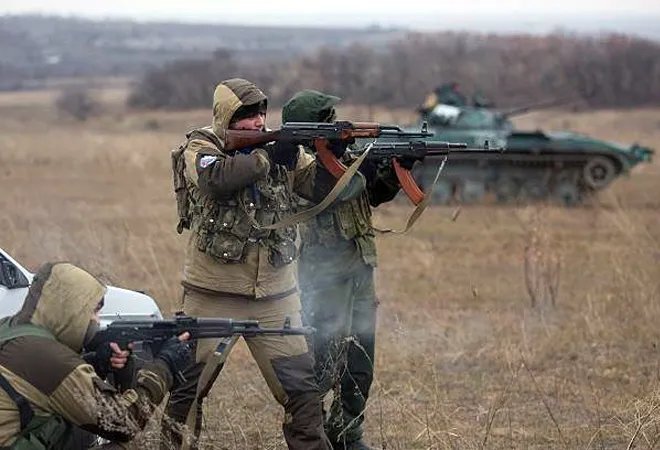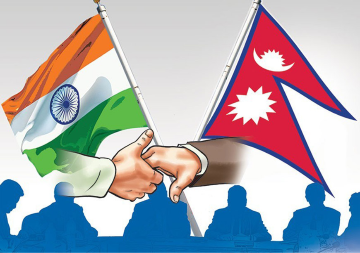
This brief is a part of
The Ukraine Crisis: Cause and Course of the Conflict.
Last Tuesday, in Tallinn, Estonia,
General Paul Nakasone, the Head of the United States (US) Cyber Command and the National Security Agency, told a British TV channel that the US was conducting offensive hacking operations in support of Ukraine in response to the Russian invasion. Studied in conjunction with the better-known role of American private firms like SpaceX, Microsoft, Amazon, and Meta, it helps explain Ukraine’s resilience in the face of a sustained Russian military attack that combines both kinetic and digital weapons.
Almost everyone expected that the Russian war on Ukraine would feature extensive use of cyber weapons. And so it has, but often in ways that were not quite anticipated. In cyber issues, it is difficult to separate fact from fiction. So, we hear a great deal about how Russian tanks have been blown up by American Javelin missiles, or the activities of the Turkish Bayraktar drones, but don’t get too many details about the intense digital war which has played a significant role in shaping the conflict.
In a recent webinar organised by the M.L. Sondhi Institute for Asia Pacific Affairs, Steven P Rosen, a Harvard College Professor specialising in national security
noted how digital operations are playing a significant role in adding to the military capabilities of one or the other side or subtracting from them. He also noted that cyber operations had variously affected the command and control systems of both Ukraine and Russia.
Viasat is a commercial US communications satellite that provides high-speed satellite broadband to commercial and military customers and the Russian attack also affected other countries in Europe.
Ukraine has no satellites of its own. So the conflict opened with
the hacking of the Viasat satellite used by the Ukrainians. Viasat is a commercial US communications satellite that provides high-speed satellite broadband to commercial and military customers and the Russian attack also affected other countries in Europe. At the time, no public accusations have been made as to who was responsible for this. But in early May, the
UK’s National Cyber Security Centre squarely accused the Russians of the action.
One surprise was that the Russians who were expected to take down Ukraine’s communications at the very outset didn’t and were selective in their attacks. While they did hack the military command and control system,
they left the civilian infrastructure largely intact. One theory is that they had expected a quick victory and wanted the network to survive and serve their own ends.
In a report last month, Microsoft said
that the Russian “digital onslaught” had begun a year before the operation. Russian cyber attackers gained access to several Ukrainian energy and IT providers by late 2021. In January, before the Russian invasion, researchers found a malware called WhisperGate in Ukrainian systems. This mirrored an earlier 2017 cyber assault that had destroyed data in thousands of systems.
With the war, these targets were hit with destructive viruses. The attacks intensified. Between 23 February and 8 April, the company had noted 37 destructive cyberattacks aimed at Ukrainian targets. The report said that many attacks were coordinated with the kinetic operations of the Russian military.
Rosen speculated that the US government used this as justification for “defensive” cyber operations that took down the Russian communications system. Their 3G net also went down which compromised the secrecy of communications between their ground forces and air force. However, General Nakasone refused to divulge the nature of US operations, but claimed the full spectrum operations, “offensive, defensive,
information” were ultimately aimed at protecting US security.
Zelensky in his olive green T-shirt speaking to world leaders and parliaments through videos and regularly messaging across social media has been a significant factor in gaining support for Ukraine.
An important consequence of Ukraine’s ability to access the outside world was President Zelensky’s ability to communicate with the world leaders and showcase himself as a symbol of Ukrainian unity in the face of the Russian attack. Zelensky in his olive green T-shirt speaking to world leaders and parliaments through videos and regularly messaging across social media has been a significant factor in gaining support for Ukraine. According to one report, a great deal of the effort to counter Russian information warfare is being played by Ukraine’s own government assisted by a volunteer army of 3 lakh Ukrainian IT techies.
Starlink in Ukraine
The most fascinating chapter of this digital struggle has been the role played by Elon Musk and his Starlink constellation. Two days after Viasat was hacked, Musk said that Starlink would be pressed into service to provide broadband connectivity in Ukraine. It has since helped in basic communications in the country, in addition to assisting its military effort through linking drones for targeting strikes. Within a month or so 10,000 Starlink terminals had been sent to the country. Unlike transmission towers, Starlink satellite dishes are just about 60 centimeters wide and portable. Russia sought to jam the systems, but Starlink technicians were able to bypass them. In addition to diverting the human technical resources to focus full-time on the cyberattacks that were launched on the Starlink system, Musk also provided gensets and solar panels to run the terminals. Besides SpaceX and Microsoft, other US companies like Amazon, Meta, Apple, and Twitter are also working with the US government to fight the cyber war against Russia. In that sense, they have made themselves vulnerable to strikes by Russian hackers and the US critical infrastructure could face direct attacks in retaliation.
The Ukrainians, with the possible help of the US and UK, cracked this wide open and were able to geolocate sensitive military targets ranging from ships, troop clusters weapons, and higher headquarters.
The destruction of the communications channels had an inevitable effect on the command and control of the two contending armies. How the Ukrainians have compensated for the hacking of the Viasat remains unclear, but there is no doubt the US and UK have helped.
The biggest problems have arisen for the Russians who used the supposedly secure ERA cryptophone based on 3G and 4G networks. This has compromised their air-to-ground coordination, as well as the command and control of their forces on the field. One major weakness of this system was that it combined secure and non-secure communications on the same platform. The Ukrainians, with the possible help of the US and UK, cracked this wide open and were able to geolocate sensitive military targets ranging from ships, troop clusters weapons, and higher headquarters. The large number of senior Russian officers killed has been attributed to real-time battlefield intelligence provided by the US. Given the widespread use of cell phones, both sides have suffered from negligent use by soldiers to call friends and family. Such phones using SIM cards can be located even when they are physically turned off.
Lessons learnt
The experience of the Ukrainian war already seems to be providing important lessons for modern armies. Besides the issues relating to the contest between drones, anti-tank missiles and precision-guided munitions, are those relating to cyber war. Despite its impressive modernisation and known capacity for electronic and cyber warfare, the Russians have found the going in the cyber battlefield difficult. Of course, we cannot accurately access the extent of assistance that the Ukrainians are getting from cyber powers like the US and UK.
While the necessity for decentralising battlefield command and control and agility of equipment and forces is not something new, the Ukraine experience does reinforce the importance of reinforcing and redoubling efforts in these areas.
The second is the importance of resiliency of the digital systems which means there must be sufficient redundancy built in to be able to take on a determined cyber-adversary. Associated with this is the importance of the quality of the EW personnel since there is little room for error in the cyber battlefield, especially when you are seeking to advance in contested territory. Next Gen systems will probably have to incorporate AI and machine learning system to achieve some of these goals.
Another important lesson is the important role that the private sector has, especially in the area of cyber warfare. Besides companies like SpaceX with its Starlink constellation, are the armies of civilian software professionals who are needed to battle digital attacks on their networks on a real-time basis.
Private sector companies have already established a niche in China, beginning with commercial launches and now they are venturing into private internet with a September-2020 application to the International Telecommunications Union for setting up two satellite constellations, totaling 13,000 satellites in the LEO.
The views expressed above belong to the author(s). ORF research and analyses now available on Telegram! Click here to access our curated content — blogs, longforms and interviews.



 This brief is a part of
This brief is a part of  PREV
PREV


